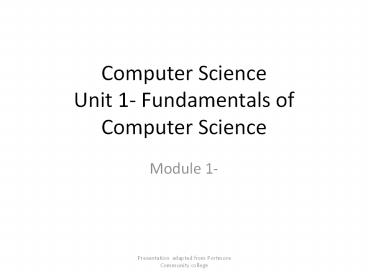Computer Science Unit 1- Fundamentals of Computer Science PowerPoint PPT Presentation
1 / 22
Title: Computer Science Unit 1- Fundamentals of Computer Science
1
Computer ScienceUnit 1- Fundamentals of Computer
Science
- Module 1-
2
Course Information
- Text
- Understanding Computer Science for Advanced Level
By Ray Bradley - Software
- DevCpp Click to Download compiler
3
Course Assessment Information
- Paper 1 30 (1 hour and 30 minutes)
- Examined on each module of syllabus total 45
marks - 45 multiple choice items
- Paper 2 50 (2 hours and 30 minutes)
- Examined on all sections of syllabus total
150 marks - Six compulsory structured questions
- Section I -two from module I (50
marks) - Section II-two from module II (50
marks) - Section III-two from module III (50
marks) - Paper 3 20 (IA)
- Examined on modules 2 and 3 total 60 marks
4
Information technology
- Information Technology (IT), is the term used to
describe the equipment, hardware and computer
programs (software), that allows us to access...
and present data and information (Gay and
Blades, 2005). - Information Technology is the integration of
various computing tools used for information
processing within todays society. It is mostly
an adventure into how we conduct business and how
we live our lives (Long, 2005). - Additionally, we can view IT as a field of study
in which we learn how best to remain competitive
in society with inventions as well as attain
vocational and life-lasting skills to use these
inventions.
5
Computer Science
- The study of the design and operation of
computer hardware and software, and of the
application of computer technology to science,
business, and the arts. (The American Heritage
Science Dictionary, 2005) - Computer science is composed of many broad
disciplines, including artificial intelligence
and software engineering.
6
Hardware Components
- Part 1 - Overview
7
Computer Architecture Organization
List how computers are used in your every day
life.
8
Computer Architecture Organization
Various uses
Some common uses of computer may include
entertainment, education, banking and
investments, shopping, research information,
collaboration and communication
9
Computer Architecture Organization
- Regardless of the respective uses we may find for
computers, they will contain most, if not all,
the following traits - Communication Consistency
Reliability - Storage Speed
- Additionally, as we use computers, we consider
its - Impact on the environment Impact on
labour force - Violation of privacy
Risks to health
10
Computer Systems
- Technically, a computer is any counting device
more specifically, it is...an electronic device
capable of interpreting and executing programmed
commands for input, output, computation, and
logic operations (Long, 2005). - Consequently, we can consider the computer system
as a set of components that interact to achieve a
common goal. The purpose, therefore, of a
computer system is to use all its working
components to produce quality information
11
Computer Architecture Organization
- For each of the following, highlight at least two
means by which we use computers - Information systems/data processing systems
- Personal computing
- Science, research, and engineering
- Process/device control
- Education
- Entertainment
- Artificial Intelligence
Speed Reliability Consistency Accuracy Storage Com
munication
12
Computer Architecture Organization
- Types of computers
13
Computer Architecture Organization
- Types of computers
Personal computers The two most popular personal
computers are PC (Windows, Linux) and Apple
Macintosh (Mac OS). Desktop computers are so
described because their components are designed
to fit on or under ones desk
14
Computer Architecture Organization
- Types of computers
- Mobile computers and mobile devices
- These technologies are small enough to carry
around in ones pocket such devices usually are
internet enabled
15
Computer Architecture Organization
- Types of computers
Midrange servers Powerful, large computer that
supports up to a few thousand computers. Mainfram
e Very powerful, expensive computer that supports
thousands of computers. Supercomputer The
fastest, most powerful, most expensive computer.
Used for applications requiring complex
mathematical calculations.
16
Computer Architecture Organization
- Types of computers
Embedded computer Typically, these computers are
special-purpose computers, with functions that
are part of a whole system.
17
Computer Architecture Organization
- Computer system components
- A computer system has only four fundamental
components - Inputhandles the gathering of data
- Processingtransformation of data to information
- Outputhandles the dissemination of processed
data - Storagesafe keeping of information for future
use - Note The computer system (and not the computer)
is made up of four components.
18
Computer Architecture Organization
- An input device is any peripheral device that
allows one to enter data or instructions into a
computer.
List five input devices ?
19
Computer Architecture Organization
- An output device is any peripheral device that
conveys information to one or more individuals.
List three output devices ?
20
Computer Architecture Organization
- The processor is the electronic component that
interprets and carries out instructions to
operate the computer system (which resides on the
motherboard)..
21
Computer Architecture Organization
- Storage components hold data, instruction, as
well as information for future use these items
are kept on storage media (which are housed
within the system unit).
List three storage media ?
22
Overview Not Enough
- Regardless of the fact that we now have an
general idea of the basic components and the
functions of a computer system, this overview is
not enough to provide us with thorough
understanding of each component. - We then seek a comprehensive understanding of
each component of the computer system by
determining how important each element is.

